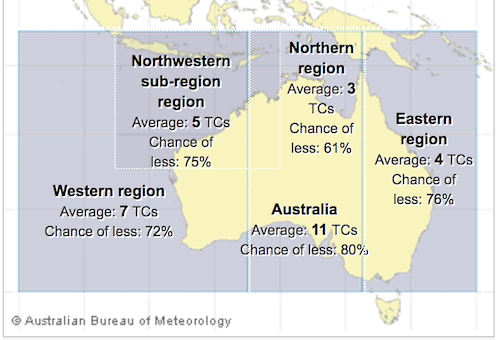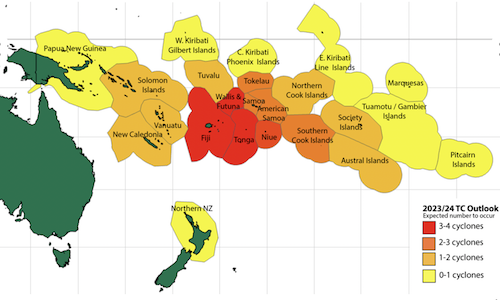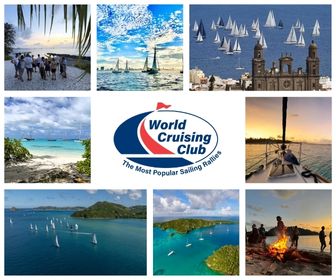South Pacific Cyclone Season 2023: Normal to Below Normal Season Predicted
While Australia’s Bureau of Meteorology is forecasting a below average number of tropical cyclones for the 2023–24 Australian tropical cyclone (TC) season (November to April), New Zealand’s NIWA and MetService assessment for the South West Pacific indicates normal to above normal activity.
Published 2 years ago
Australian Outlook
In its tropical cyclone season long-range forecast for 2023 to 2024, Australia’s Bureau of Meterology (BOM) says the El Niño event in the tropical Pacific Ocean has influenced this year’s tropical cyclone season forecast.
On average, 11 tropical cyclones form in a season in the Australia region, with four typically crossing the Australian coast, since reliable records began in 1969–70.
In El Niño years, the first cyclone to make landfall on the Australian coast typically occurs later than normal, around the second week of January. El Niño typically reduces the total number of tropical cyclones which form in the Australian region (compared to the long-term average), as well as the number of coastal crossings; however, at least one tropical cyclone has crossed the Australian coastline in every season since reliable records began in the 1970s.
This forecast is based on the analysis of El Niño–Southern Oscillation (ENSO) oceanic and atmospheric indicators over the preceding July to September. El Niño conditions were established in the tropical Pacific in September 2023. Prior to that, the last El Niño declared by the Bureau was in 2015–16. During July and August 2023, oceanic patterns were El Niño-like, but the atmospheric response to the warm sea surface temperatures in the central and eastern Pacific was not apparent. Climate models suggest this El Niño will persist until at least the end of the coming Australian summer.


Southwest Pacific Tropical Cyclone Outlook
New Zealand’s National Institute of Water and Atmospheric Research (NIWA) and MetService have released their assessment of tropical cyclone (TC) activity for the coming season which indicates normal to above normal activity.
NIWA’s outlook says nine to 14 named tropical cyclones could occur in the Southwest Pacific from November 2023 to April 2024.
Vanuatu and New Caledonia typically experience the greatest TC activity with an average of two or three named tropical cyclones passing nearby each year. Between four to eight severe tropical cyclones reaching Category 3* or higher may occur anywhere across the region, so all communities should remain prepared.


Fiji Outlook
Analysis from the Fiji Meteorological Service indicates that two to three tropical cyclones are likely to pass through Fiji’s Exclusive Economic Zone during the 2023-24 tropical cyclone season, out of which one to two may reach severe tropical cyclone status, that is, Category 3* or higher intensity.
While the peak tropical cyclone activities in the Pacific Island region is usually from January to March, tropical cyclones can form at any time during the season. Furthermore, out of season tropical cyclones cannot be ruled out. Tropical cyclones have occasionally occurred in the region during October and May and sometimes in even September and June.
A detailed version of the 2023-24 tropical cyclone seasonal outlook issued by the Fiji Meteorological Service is available on the official website of the Department.
For those who plan to stay in Fiji for the season, Port Denarau Marina publish a Cyclone Procedures document which contains useful information for those staying in Fiji for the cyclone season.
………………………………
*Tropical cyclones are categorised in strength from 1 to 5, with 5 being most intense. Tropical cyclones that reach category 3 or higher are classified as severe, with mean (10 minute) wind speeds of at least 119 km/h.
………………………………
Related News:
- Australian Tropical Cyclone Season Long Range Forecast for 2023 – 2024
- NIWA Southwest Pacific Tropical Cyclone Outlook – October 2023
- Fiji Meterological Service Tropical Cyclone Outlook 2023-2024
………………………………
Related Links:
- Noonsite Weather Resources
- Bureau of Meteorology Australia
- NIWA – New Zealand
- Fiji Meteorological Service
- Port Denarau Marina Cyclone Procedures
………………………………
Find out all news, reports, links and comments posted on Noonsite, plus cruising information from around the world, by subscribing to our FREE monthly newsletter. Go to https://www.noonsite.com/newsletter/.
Related to following destinations: Aitutaki, Aiwo, Alofi, Ambrym, American Samoa, Anatom Island (Aneityum), Apia (Upolu), Atafu, Atiu Island, Auckland, Australia, Australs, Banks Islands, Bougainville, Chesterfield Islands, Clipperton Atoll, Cook Islands, Darwin, Efate, Epi Island, Espiritu Santo, Fakaofo, Fiji, French Polynesia, Funafuti, Futuna, Gambiers, Gove, Groote Eylandt - Milner Bay, Hienghene, Ile des Pins, Kadavu, Koumac, Lau Group, Lifou Island (We), Lifuka (Ha'apai), Maewo Island, Main Island, Malekula Island, Mamanucas and Yasawas, Manihiki, Marquesas, Nauru, Neiafu (Vava'u), New Britain Island, New Caledonia, New Ireland, New South Wales, New Zealand, Niuafo'ou Island, Niuatoputapu Island, Niue, North Island (New Zealand), Northern Group (Cook Islands), Northern Territory (Australia), Noumea, Nuku'alofa (Tongatapu), Nukunono, Opua (Bay of Islands), Other Atolls (French Polynesia), Other Outer Islands (PNG), Outer Atolls (Tuvalu), Ovalau, Pago Pago, Palmerston, Papua New Guinea, Penrhyn, Pukapuka, Queensland, Rarotonga, Rotuma, Salelologa Harbour (Savai'i Island), Samoa, Society Islands, Southern Cook Islands, Suwarrow, Tahiti, Tanna, Taveuni, Tokelau, Tonga, Touho, Tuamotus, Tuvalu, Vanua Levu, Vanuatu, Viti Levu, Wallis, Wallis and Futuna, Western Australia, Western Samoa
Related to the following Cruising Resources: Hurricanes and Tropical Cyclones, Weather









